Disclosure: My dog blog is supported by dog parents just like you. I only recommend products that I would use on my dogs. All opinions expressed here are my own. I sometimes earn a small affiliate commission, at no extra cost to you, when you click through the affiliate link and purchase something. You can read more about my affiliate policy here.
April is National Pet First Aid Awareness Month. As responsible dog parents, we should prepare for a first aid emergency. For instance, creating a DIY dog first aid kit is a step in preparation.
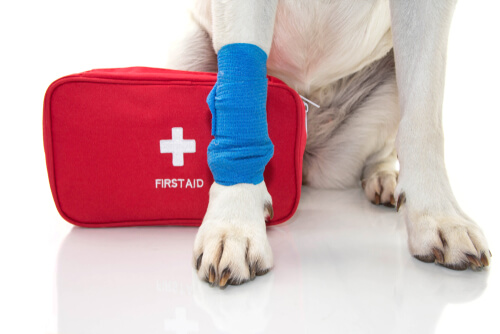
Furthermore, if you have a dog first aid kit, make sure the supplies are up to date. In fact, it’s a good idea to check your dog first aid kit every few months.
Having the essentials on hand can mean life or death in the event of an emergency. Plus, you never know what can happen whether at home or out camping with your dog. So, it’s important to be prepared with a dog first aid kit. Read this to know the three essential dog first aid steps.
Do you have a first aid kit for your family? If you don’t, you should! If you do, then many of the items in it can be used in a dog first aid kit.
What to Put Your Dog First Aid Kit Essentials In
First of all, you need to think about being able to easily pick up your kit. For instance, you want to be able to carry it to wherever your dog might need treatment.
Therefore, put your dog first aid kit essentials in a backpack or shoulder bag. In addition, you will be able to travel with it on road trips, or going camping, or hiking.
However, you have the option to have two kits, one for home and one for travel. If you choose this option, then your home kit can be a tote or bin with a lid.
There is an advantage and peace of mind to having two kits. As a result, you can leave one in the car guaranteeing it isn’t left behind.

Now This Is Something To Bark About!!
10 Essentials to Pack in a Dog First Aid Kit
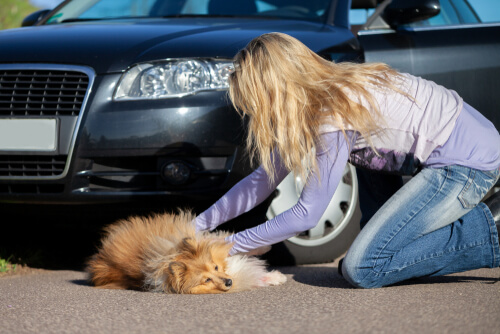
Snoot and Toebeans want you to be ready for an emergency with a dog first aid kit. Therefore, we have put together a list of essential items to put in your dog first aid kit. Several items have been combined into a group, because they just go together. You can download a printable version of this list.
1. Pet Emergency Care Handbook
The VCA Veterinary Specialty Center of Seattle created a booklet to help in the event of an emergency. In addition, the booklet is intended to help you prevent and deal with emergency situations with your dog.
However, it should not in any way replace professional veterinary care. Nevertheless, the information provided will help you handle your dog’s condition until you get further help.
2. Your Dog’s Paperwork
It’s a good idea to keep your dog’s vaccination and medical records in your dog first aid kit. Therefore, if you go to the emergency vet, they can provide better care knowing your dog’s medical history.
Furthermore, keep a list of important phone numbers. For example, these can include veterinarian, emergency clinic, poison control, animal control, and non-emergency police phone numbers.
3. Medications
Do you have a dog that takes prescription medications? You can ask your veterinarian about keeping an extra supply in your dog first aid kit. Furthermore, an extra supply might come in handy if you lose or misplace medication while traveling.
In addition, talk to your veterinarian about other useful, over the counter medication. For example, these could include flea/tick meds, antacids, or other stomach issue drugs. Plus, if you have an anxious dog, you can ask your veterinarian about dog CBD products.
Most importantly, check periodically to make sure that any medications in your kit haven’t expired.
4. Non-stinging Antiseptic Solution
Saline solution is going to be the best product when it comes to cleaning wounds. For instance, the salt has mild antibacterial properties. Plus, when it is made correctly, it has the same makeup as body tissue. In addition, it is gentle on vital healing cells.
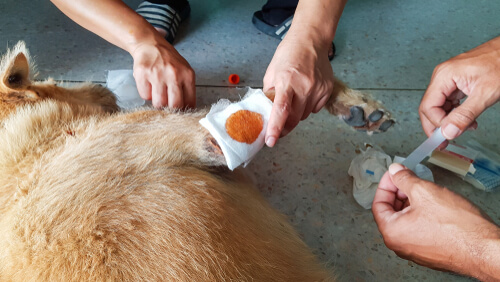
However, it is important to use a large volume when washing the wound. Therefore, it flushes debris and contamination from the wound acting as a mild disinfectant. You can even use contact lens cleaning saline solution.
Chlorhexidine is also extremely effective. Plus, it’s cheap and readily available. Using a 2% solution limits tissue irritation. However, 4% solutions are also commonly used. Povidone-iodine solution is another good option.
5. Hydrogen Peroxide
Hydrogen peroxide can also be used for cleansing a wound. However, you should be aware that the use of hydrogen peroxide is controversial. For instance, although it kills bacteria, it can also damage living tissue.
So, if you do decide to cleanse a dog wound with it, make sure to dilute it appropriately. Thus, for every one part of 3% hydrogen peroxide, dilute with three parts water. As a result, it makes a useful disinfectant and is considered safe for minor wounds.
In addition to cleaning minor wounds, hydrogen peroxide can be used to induce vomiting. To clarify, if your dog has ingested something toxic, you may want to induce vomiting.
However, before doing so, you will need to contact your veterinarian or poison control center. That is to say, do NOT attempt to induce vomiting without professional guidance.

6. Antibacterial Ointment
If your dog gets a cut or a scratch, an antibiotic ointment will help prevent infection. In addition, it will relieve pain and act as a barrier from bacteria and germs.
Therefore, an antibacterial ointment is good to keep in a dog first aid kit. For instance, even minor cuts and scrapes can become infected leading to major health problems.
Most importantly, use a triple antibiotic ointment that contains bacitracin, neomycin, and Polymyxin B. Plus, these are widely available.
In addition, AVOID products that contain corticosteroid. In other words, don’t use hydrocortisone. Read the side effects of corticosteroids in dogs here.
7. Gauze, Tape, Scissors or a Razor, Protective Gloves
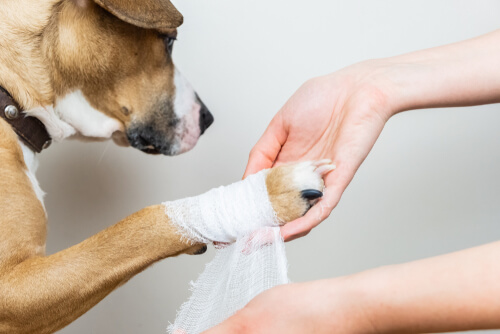
These items work together in an emergency situation. Gauze can serve a few purposes. For starters, gauze can help control bleeding when wrapping the wound. Plus, it can act as a temporary brace for a suspected fracture.
Furthermore, gauze can be used as a makeshift muzzle for an injured dog. You can also keep a muzzle in your dog first aid kit. Why would you want to muzzle your dog?
It’s important to prevent you or someone helping you in an emergency from a dog bite. However, DO NOT muzzle your dog if he or she is vomiting.
A good tape is great for securing bandages. For example, it can hold gauze or other first aid items in place. You can use nonstick, adhesive, and waterproof tapes.
Blunt tipped scissors or a razor come in handy for cutting gauze, tape, or bandages. Furthermore, if you have to use the shirt off your back, scissors will cut it into strips. Then, the strips can be used as bandages. In addition, scissors or a razor can be used to cut the hair away from a wound.
It is a good idea to wear some type of protective gloves when dealing with blood or bodily fluids. For example, you can use rubber gloves or disposable gloves.
8. Wet or Grooming Wipes and Poop Bags
Trust me, if your dog poops in your car, you’ll be glad you have wipes and poop bags in your dog first aid kit. In addition, both items will come in handy to clean up puke while traveling.
Furthermore, use wet or grooming wipes to clean dirt or blood off of a wound. You can also wipe your dog down after he or she rolls around in unknown grassy areas. Plus, they’re good for cleaning off muddy paws.

9. Water, Food/Treats, and Bowls
Hydration is super important. Furthermore, keeping your dog vitally hydrated whether traveling or hiking is a must. Therefore, keep a bottle of water in your dog first aid kit.
In addition, keep some food and treats on hand. These could be helpful during an emergency. For example, you might use either to distract your dog while you perform an emergency procedure.
You will need something to dispense, especially water, to your dog. Collapsible bowls are great to keep in a dog first aid kit. For instance, since they collapse, they do not take up as much room.
10. Towel or Blanket and Old Comfort Object
A towel or blanket can be used a couple of ways during an emergency situation. First, use it for restraining and calming an injured dog. Gently wrapping your dog in a towel or blanket can keep them from panicking. Plus, it might keep you from being bitten.
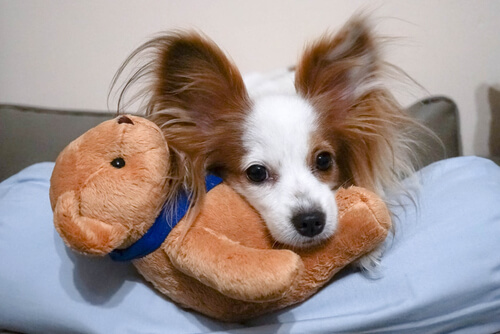
Secondly, a towel or blanket can offer a soft surface for your dog while you examine the injuries. A towel or blanket made of microfiber is a great choice, because it is ultra absorbent.
Going hand in hand with a towel or blanket is keeping an old comfort object in your kit. For instance, an old favorite toy or blanket can help calm, soothe, and comfort your dog… especially during a traumatizing situation.
Some Other Items to Consider Putting in a Dog First Aid Kit
There are so many essentials that can be useful when it comes to an emergency with your dog. So, once you’ve packed the above 10 items, consider the following for your dog first aid kit.
- Spare leash and collar for securing your dog in case his or hers breaks
- Flashlight and batteries for nighttime emergencies or when you need extra light for observing wounds
- Digital or rectal thermometer for taking your dog’s temperature
- Eye dropper, turkey baster, or rubber bulb syringe for giving oral treatments or for flushing wounds
- Milk of magnesia or activated charcoal for absorbing poison (use with the guidance of your veterinarian or poison control center)
- Septic liquid for stopping minor bleeding
- Tweezers for removing splinters
In Conclusion
When your dog does get hurt, it is best to seek professional veterinary treatment. However, a dog first aid kit will come in handy until you can get to the veterinarian.
What will you include in your dog first aid kit? Are there any essentials we missed? Let us know in the comments below!
You might be interested in these posts from our dog blog:
- Dog Bite Prevention at the Forefront in April
- Dog First Aid – the Essentials to Know
- Animal Disaster Preparedness Keeps Pets Safe
You can use one of the following images to pin to your Pinterest account.
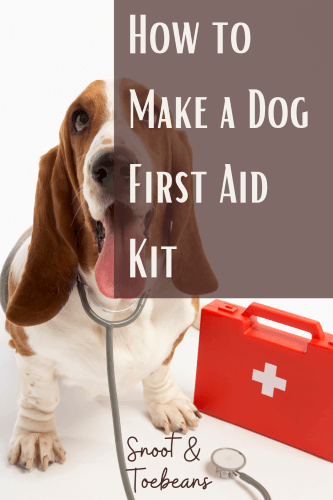
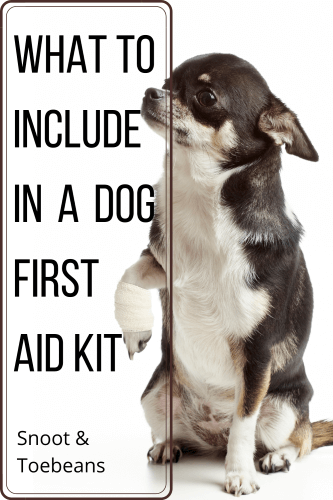
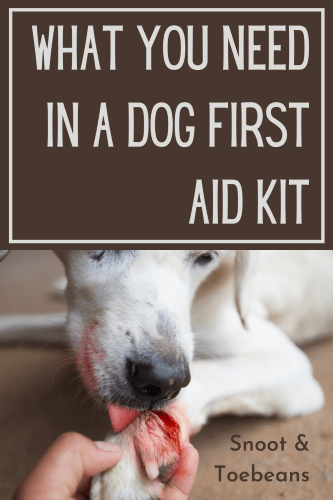
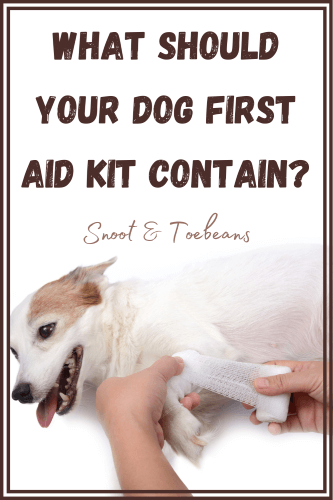
We Give Back 15%
Through each digital product we sell in our SNOOT shop, we give back 15% to the greater dog community outside our web space. For instance, each product has an amazing cause to support…
Paw-esomely Fun Paw Print Art eBook ➡ Project Freedom Ride
The Kid’s Dog Treat Cookbook ➡ Bark Reading Dogs

